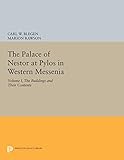The Palace of Nestor at Pylos in Western Messenia, Vol. 1 : The Buildings and Their Contents / ed. by Marion Rawson, Carl William Blegen.
Material type: TextSeries: Princeton Legacy Library ; 1917Publisher: Princeton, NJ : Princeton University Press, [2015]Copyright date: ©1966Description: 1 online resource (472 p.)Content type:
TextSeries: Princeton Legacy Library ; 1917Publisher: Princeton, NJ : Princeton University Press, [2015]Copyright date: ©1966Description: 1 online resource (472 p.)Content type: - 9780691623627
- 9781400879687
- 913.38903 23
- NA277 .P356 2015eb vol. 1
- online - DeGruyter
- Issued also in print.
| Item type | Current library | Call number | URL | Status | Notes | Barcode | |
|---|---|---|---|---|---|---|---|
 eBook
eBook
|
Biblioteca "Angelicum" Pont. Univ. S.Tommaso d'Aquino Nuvola online | online - DeGruyter (Browse shelf(Opens below)) | Online access | Not for loan (Accesso limitato) | Accesso per gli utenti autorizzati / Access for authorized users | (dgr)9781400879687 |
Browsing Biblioteca "Angelicum" Pont. Univ. S.Tommaso d'Aquino shelves, Shelving location: Nuvola online Close shelf browser (Hides shelf browser)

|

|

|

|

|

|

|
||
| online - DeGruyter Sakamato Ryoma and the Meiji Restoration / | online - DeGruyter Soviet Strategies in Southeast Asia : An Exploration of Eastern Policy under Lenin and Stalin / | online - DeGruyter Excavations at Nessana, Volume 3 : Non-Literary Papyri / | online - DeGruyter The Palace of Nestor at Pylos in Western Messenia, Vol. 1 : The Buildings and Their Contents / | online - DeGruyter Anticipations and Purchases : An Analysis of Consumer Behavior / | online - DeGruyter Economic Planning for the Peace / | online - DeGruyter Capital in Manufacturing and Mining : Its Formation and Financing / |
Frontmatter -- Foreword -- Contents -- Illustrations -- Abbreviations -- History of the excavation -- The site -- Buildings and building materials -- Main building -- Southwestern building -- Northwestern buildings -- Northwestern building -- Area between northeastern building and wine magazine -- Wine magazine -- The pottery -- Character, date, and identification of the palace -- Index -- Map
restricted access online access with authorization star
http://purl.org/coar/access_right/c_16ec
Homer's King Nestor of "sandy Pylas" passes from legend into history in this first volume of the report of excavations on a hill called Englianos in Messenia, conducted by the Archaeological Expedition of the University of Cincinnati. The palace with its contents and the surrounding lower town indicate that this was an administrative center and the capital of a prosperous Mycenaean kingdom. The name Pylos appears on more than fifty tablets, and there can be no doubt that this was the Messenian abode of the Nestor of Greek tradition. Destroyed by fire at the end of the 13th century B.C., and never reoccupied, the palace has lain for more than 3,000 years in ruins. During the annual campaigns of the Expedition between 1952 and 1964, it emerged as a complex of four separate structures of considerable size. The floors, stumps of wall bearing plaster with painted decorations, doorways, and other evidence helped to identify gateways, courts, porticoes, vestibules, corridors, a great throne room, storerooms, a wine magazine, pantries filled with pottery, a bathroom, stairways, and a repair shop. Except for the tablets, seals, and frescoes, which will be described in other volumes, all the finds are recorded and illustrated with plans, drawings, and photographs.Originally published in 1966.The Princeton Legacy Library uses the latest print-on-demand technology to again make available previously out-of-print books from the distinguished backlist of Princeton University Press. These editions preserve the original texts of these important books while presenting them in durable paperback and hardcover editions. The goal of the Princeton Legacy Library is to vastly increase access to the rich scholarly heritage found in the thousands of books published by Princeton University Press since its founding in 1905.
Issued also in print.
Mode of access: Internet via World Wide Web.
In English.
Description based on online resource; title from PDF title page (publisher's Web site, viewed 30. Aug 2021)


